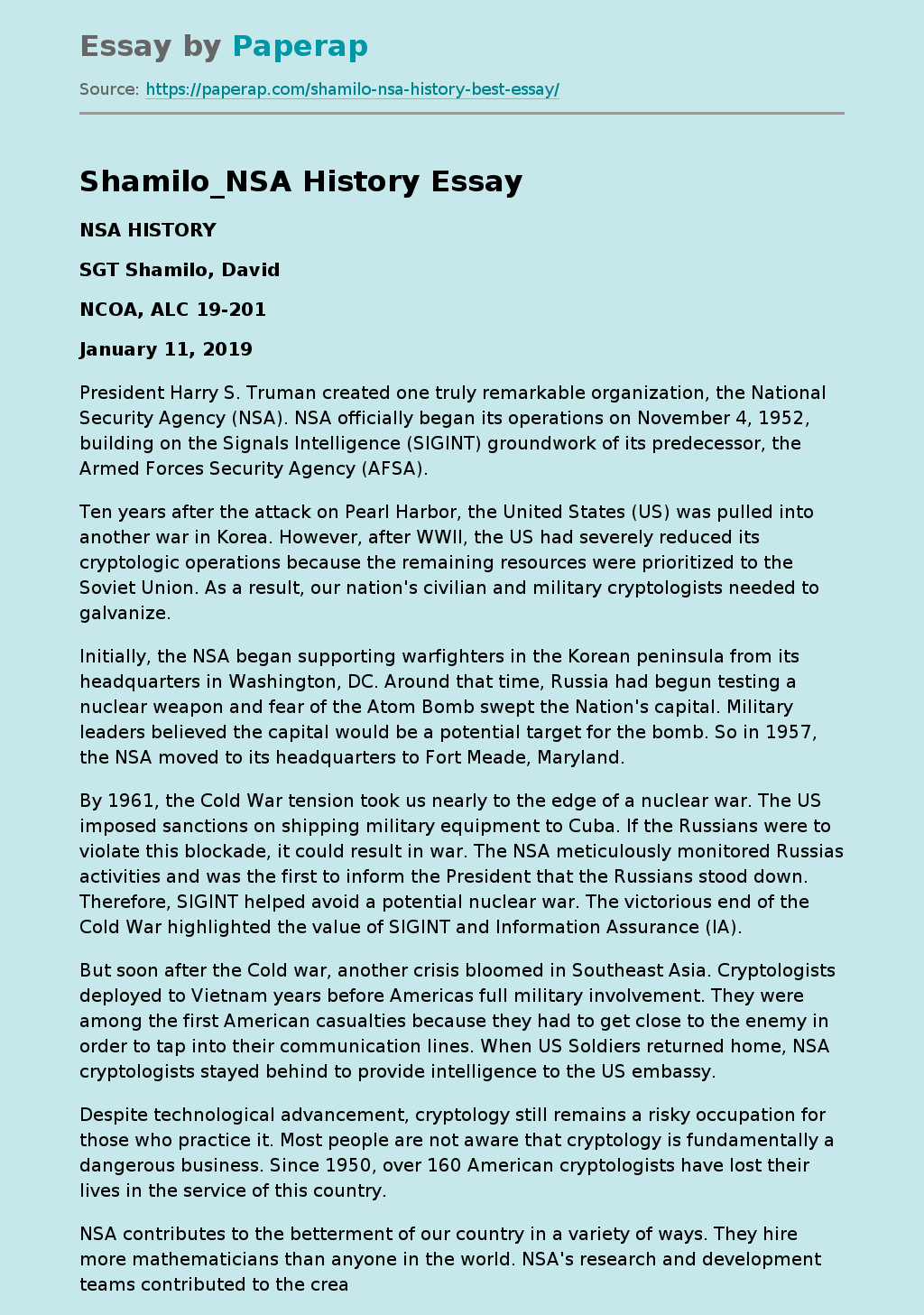Shamilo_NSA History
NSA HISTORY
SGT Shamilo, David
NCOA, ALC 19-201
January 11, 2019
President Harry S. Truman created one truly remarkable organization, the National Security Agency (NSA). NSA officially began its operations on November 4, 1952, building on the Signals Intelligence (SIGINT) groundwork of its predecessor, the Armed Forces Security Agency (AFSA).
Ten years after the attack on Pearl Harbor, the United States (US) was pulled into another war in Korea. However, after WWII, the US had severely reduced its cryptologic operations because the remaining resources were prioritized to the Soviet Union.
As a result, our nation’s civilian and military cryptologists needed to galvanize.
Initially, the NSA began supporting warfighters in the Korean peninsula from its headquarters in Washington, DC. Around that time, Russia had begun testing a nuclear weapon and fear of the Atom Bomb swept the Nation’s capital. Military leaders believed the capital would be a potential target for the bomb. So in 1957, the NSA moved to its headquarters to Fort Meade, Maryland.
By 1961, the Cold War tension took us nearly to the edge of a nuclear war. The US imposed sanctions on shipping military equipment to Cuba. If the Russians were to violate this blockade, it could result in war. The NSA meticulously monitored Russias activities and was the first to inform the President that the Russians stood down. Therefore, SIGINT helped avoid a potential nuclear war. The victorious end of the Cold War highlighted the value of SIGINT and Information Assurance (IA).
But soon after the Cold war, another crisis bloomed in Southeast Asia.
Cryptologists deployed to Vietnam years before Americas full military involvement. They were among the first American casualties because they had to get close to the enemy in order to tap into their communication lines. When US Soldiers returned home, NSA cryptologists stayed behind to provide intelligence to the US embassy.
Despite technological advancement, cryptology still remains a risky occupation for those who practice it. Most people are not aware that cryptology is fundamentally a dangerous business. Since 1950, over 160 American cryptologists have lost their lives in the service of this country.
NSA contributes to the betterment of our country in a variety of ways. They hire more mathematicians than anyone in the world. NSA’s research and development teams contributed to the creation of the supercomputer, quantum mathematics, and Android operating system. NSA also provides program management and contract services for small businesses. Today, the NSA continues to support policy makers and military leaders in battlegrounds all over the world with current and actionable intelligence through highly sophisticated channels.
References
Boak, David G. (July 1973). A History of U.S. Communications Security; the David G. Boak Lectures, Vol 1. Nestor in Vietnam, Ft. George G. Meade, MD: National Security Agency. Retrieved 14 Jan 2019.
Gold, Hadas (June 12, 2013) 10 things to know about the NSA. Retrieved 14 Jan 2019.
Goldman, Jerry, ed and Stien, Giel (October 8, 1997). “The Cuban Missile Crisis”. History and Politics Out Loud. Northwestern University. Retrieved 14 Jan 2019.
Howe, George F. (date published unk) The Early History of NSA. Retrieved 14 Jan 2019.
National Security Agency (date published unk) The Korean War Retrieved 14 Jan 2019.
National Security Agency (date published unk) National Cryptologic Memorial Retrieved 14 Jan 2019. Security Agency, (date published unk) Acquisition Resource Center. Contracting services. Retrieved 14 Jan 2019. Security Agency (July 19, 2017) NSA’s Key Role in Major Developments in Computer Science Retrieved 15 Jan 2019.
Rich, Steven and Gellman, Barton (January 2, 2014) NSA seeks to build quantum computer. Retrieved 15 Jan 2019.
Math.uh.edu (date published unk). What kind of job can I get with a major in mathematics? NSA employs more mathematicians than. Retrieved 14 Jan 2019.
Petrovan, Bogdan (4 July 2013) NSA contributed code to Android Retrieved 15 Jan 2019.
Shamilo_NSA History. (2019, Dec 06). Retrieved from https://paperap.com/shamilo-nsa-history-best-essay/

